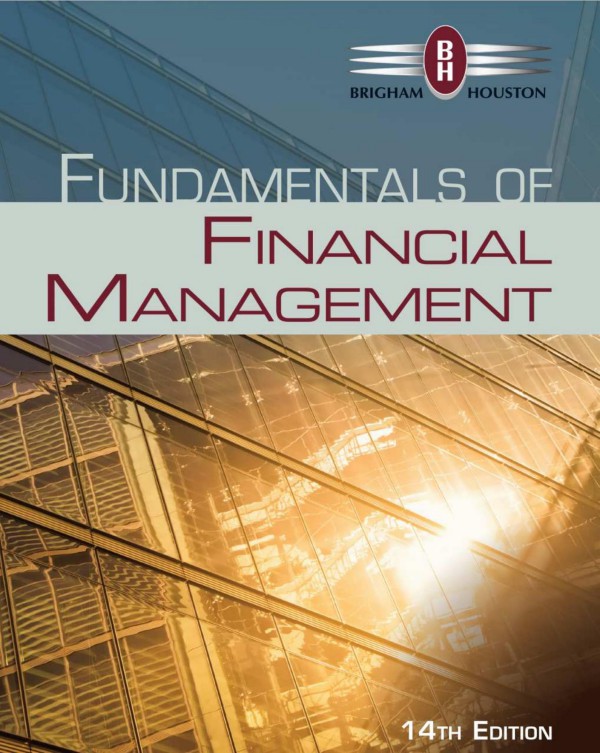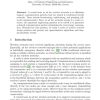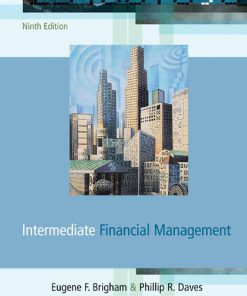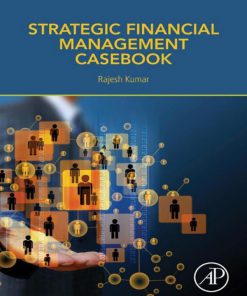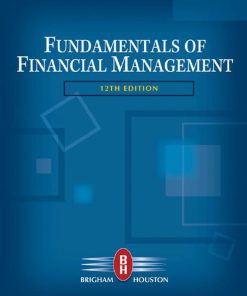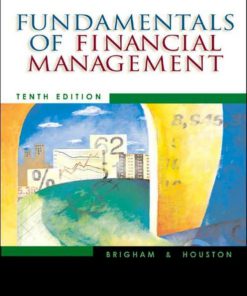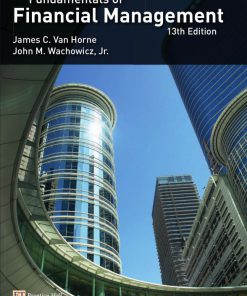Fundamentals of Financial Management 14th edition by Brigham, Houston ISBN 1285867971 978-1285867977
$50.00 Original price was: $50.00.$25.00Current price is: $25.00.
Authors:Eugene F. Brigham, Joel F. Houston , Series:Management [875] , Author sort:Eugene F. Brigham, Joel F. Houston , Languages:Languages:eng , Publisher:Cengage Learning
Fundamentals of Financial Management 14th edition by Brigham, Houston – Ebook PDF Instant Download/Delivery. 1285867971 978-1285867977
Full download Fundamentals of Financial Management 14th edition after payment
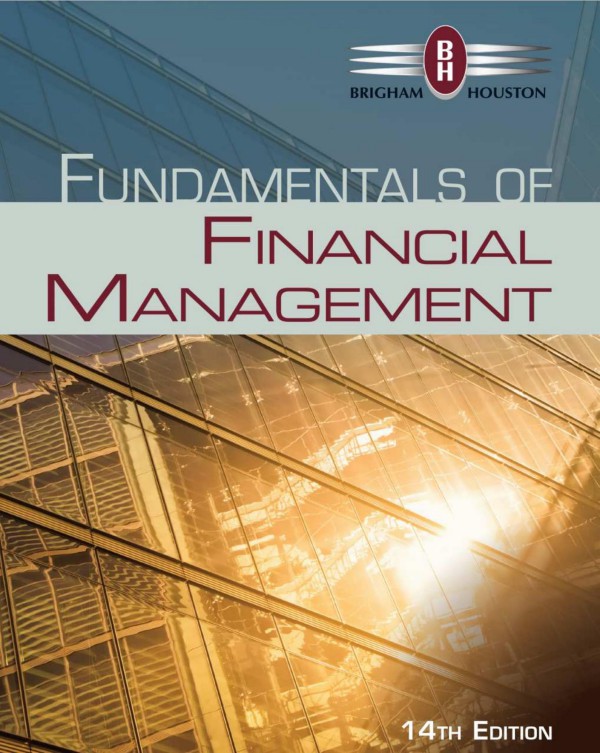
Product details:
ISBN 10: 1285867971
ISBN 13: 978-1285867977
Author: Brigham, Houston
Thoroughly updated to reflect the latest trends, developments, and practices from the field, FUNDAMENTALS OF FINANCIAL MANAGEMENT, 14e equips you with a focused understanding of today’s corporate finance and financial management. This market-leading text offers a unique balance of clear concepts, contemporary theory, and practical applications in order to help you understand the concepts and reasons behind corporate budgeting, financing, working capital decision making, forecasting, valuation, and Time Value of Money (TVM). Offering the most cutting-edge coverage available, the Fourteenth Edition includes discussions of the federal debt, the ongoing recovery of financial markets, and the European debt crisis. Numerous practical examples, “Quick Questions”, problem-solving tutorials, and Integrated Cases help you put theory into action. In addition, Excel Spreadsheet Models help you master this critical software tool.
Fundamentals of Financial Management 14th Table of contents:
Part 1. Introduction to Financial Management
Chapter 1. An Overview of Financial Management
1-1. What Is Finance?
1-1a. Areas of Finance
1-1b. Finance Within an Organization
1-1c. Finance versus Economics and Accounting
1-2. Jobs in Finance
1-3. Forms of Business Organization
1-4. The Main Financial Goal: Creating Value for Investors
1-4a. Determinants of Value
1-4b. Intrinsic Value
1-4c. Consequences of Having a Short-Run Focus
1-5. Stockholder–Manager Conflicts
1-5a. Compensation Packages
1-5b. Direct Stockholder Intervention
1-5c. Managers’ Response
1-6. Stockholder–Debtholder Conflicts
1-7. Balancing Shareholder Interests and the Interests of Society
1-8. Business Ethics
1-8a. What Companies Are Doing?
1-8b. Consequences of Unethical Behavior
1-8c. How Should Employees Deal with Unethical Behavior?
Tying It All Together
Self-Test Questions
Questions
Chapter 2. Financial Markets and Institutions
2-1. The Capital Allocation Process
2-2. Financial Markets
2-2a. Types of Markets
2-2b. Recent Trends
2-3. Financial Institutions
2-4. The Stock Market
2-4a. Physical Location Stock Exchanges
2-4b. Over-the-Counter (OTC) and the NASDAQ Stock Markets
2-5. The Market for Common Stock
2-5a. Types of Stock Market Transactions
2-6. Stock Markets and Returns
2-6a. Stock Market Reporting
2-6b. Stock Market Returns
2-7. Stock Market Efficiency
2-7a. Behavioral Finance Theory
2-7b. Conclusions about Market Efficiency
Tying It All Together
Self-Test Questions
Questions
Integrated Case. Smyth Barry & Company
Part 2. Fundamental Concepts in Financial Management
Chapter 3. Financial Statements, Cash Flow, and Taxes
3-1. Financial Statements and Reports
3-2. The Balance Sheet
3-2a. Allied’s Balance Sheet
3-3. The Income Statement
3-4. Statement of Cash Flows
3-5. Statement of Stockholders’ Equity
3-6. Uses and Limitations of Financial Statements
3-7. Free Cash Flow
3-8. MVA and EVA
3-9. Income Taxes
3-9a. Individual Taxes
3-9b. Corporate Taxes
Tying It All Together
Self-Test Questions
Questions
Problems
Comprehensive/Spreadsheet Problem
Integrated Case. D’Leon Inc., Part I
Chapter 4. Analysis of Financial Statements
4-1. Ratio Analysis
4-2. Liquidity Ratios
4-2a. Current Ratio
4-2b. Quick, or Acid Test, Ratio
4-3. Asset Management Ratios
4-3a. Inventory Turnover Ratio
4-3b. Days Sales Outstanding
4-3c. Fixed Assets Turnover Ratio
4-3d. Total Assets Turnover Ratio
4-4. Debt Management Ratios
4-4a. Total Debt to Total Capital
4-4b. Times-Interest-Earned Ratio
4-5. Profitability Ratios
4-5a. Operating Margin
4-5b. Profit Margin
4-5c. Return on Total Assets
4-5d. Return on Common Equity
4-5e. Return on Invested Capital
4-5f. Basic Earning Power (BEP) Ratio
4-6. Market Value Ratios
4-6a. Price/Earnings Ratio
4-6b. Market/Book Ratio
4-7. Tying the Ratios Together: The DuPont Equation
4-8. Potential Misuses of ROE
4-9. Using Financial Ratios to Assess Performance
4-9a. Comparison to Industry Average
4-9b. Benchmarking
4-9c. Trend Analysis
4-10. Uses and Limitations of Ratios
4-11. Looking Beyond the Numbers
Tying It All Together
Self-Test Questions
Questions
Problems
Comprehensive/Spreadsheet Problem
Integrated Case. D’Leon Inc., Part II
Chapter 5. Time Value of Money
5-1. Time Lines
5-2. Future Values
5-2a. Step-by-Step Approach
5-2b. Formula Approach
5-2c. Financial Calculators
5-2d. Spreadsheets
5-2e. Graphic View of the Compounding Process
5-3. Present Values
5-3a. Graphic View of the Discounting Process
5-4. Finding the Interest Rate, I
5-5. Finding the Number of Years, N
5-6. Annuities
5-7. Future Value of an Ordinary Annuity
5-8. Future Value of an Annuity Due
5-9. Present Value of an Ordinary Annuity
5-10. Finding Annuity Payments, Periods, and Interest Rates
5-10a. Finding Annuity Payments, Pmt
5-10b. Finding the Number of Periods, N
5-10c. Finding the Interest Rate, I
5-11. Perpetuities
5-12. Uneven Cash Flows
5-13. Future Value of an Uneven Cash Flow Stream
5-14. Solving for I with Uneven Cash Flows
5-15. Semiannual and Other Compounding Periods
5-16. Comparing Interest Rates
5-17. Fractional Time Periods
5-18. Amortized Loans
Tying It All Together
Self-Test Questions
Questions
Problems
Comprehensive/Spreadsheet Problem
Integrated Case. First National Bank
Part 3. Financial Assets
Chapter 6. Interest Rates
6-1. The Cost of Money
6-2. Interest Rate Levels
6-3. The Determinants of Market Interest Rates
6-3a. The Real Risk-Free Rate of Interest, r*
6-3b. The Nominal, or Quoted, Risk-Free Rate of Interest, r RF = r * + IP
6-3c. Inflation Premium (IP)
6-3d. Default Risk Premium (DRP)
6-3e. Liquidity Premium (LP)
6-3f. Interest Rate Risk and the Maturity Risk Premium (MRP)
6-4. The Term Structure of Interest Rates
6-5. What Determines the Shape of the Yield Curve?
6-6. Using the Yield Curve to Estimate Future Interest Rates
6-7. Macroeconomic Factors That Influence Interest Rate Levels
6-7a. Federal Reserve Policy
6-7b. Federal Budget Deficits or Surpluses
6-7c. International Factors
6-7d. Business Activity
6-8. Interest Rates and Business Decisions
Tying It All Together
Self-Test Questions
Questions
Problems
Comprehensive/Spreadsheet Problem
Integrated Case. Morton Handley & Company
Chapter 7. Bonds and Their Valuation
7-1. Who Issues Bonds?
7-2. Key Characteristics of Bonds
7-2a. Par Value
7-2b. Coupon Interest Rate
7-2c. Maturity Date
7-2d. Call Provisions
7-2e. Sinking Funds
7-2f. Other Features
7-3. Bond Valuation
7-4. Bond Yields
7-4a. Yield to Maturity
7-4b. Yield to Call
7-5. Changes in Bond Values Over Time
7-6. Bonds with Semiannual Coupons
7-7. Assessing a Bond’s Riskiness
7-7a. Price Risk
7-7b. Reinvestment Risk
7-7c. Comparing Price Risk and Reinvestment Risk
7-8. Default Risk
7-8a. Various Types of Corporate Bonds
7-8b. Bond Ratings
7-8c. Bankruptcy and Reorganization
7-9. Bond Markets
Tying It All Together
Self-Test Questions
Questions
Problems
Comprehensive/Spreadsheet Problem
Integrated Case. Western Money Management Inc.
Chapter 8. Risk and Rates of Return
8-1. The Risk-Return Trade-Off
8-2. Stand-Alone Risk
8-2a. Statistical Measures of Stand-Alone Risk
8-2b. Measuring Stand-Alone Risk: The Standard Deviation
8-2c. Using Historical Data to Measure Risk
8-2d. Measuring Stand-Alone Risk: The Coefficient of Variation
8-2e. Risk Aversion and Required Returns
8-3. Risk in a Portfolio Context: The CAPM
8-3a. Expected Portfolio Returns, r ^ p
8-3b. Portfolio Risk
8-3c. Risk in a Portfolio Context: The Beta Coefficient
8-4. The Relationship Between Risk and Rates of Return
8-4a. The Impact of Expected Inflation
8-4b. Changes in Risk Aversion
8-4c. Changes in a Stock’s Beta Coefficient
8-5. Some Concerns About Beta and the CAPM
8-6. Some Concluding Thoughts: Implications for Corporate Managers and Investors
Tying It All Together
Self-Test Questions
Questions
Problems
Comprehensive/Spreadsheet Problem
Integrated Case. Merrill Finch Inc.
Chapter 9. Stocks and Their Valuation
9-1. Legal Rights and Privileges of Common Stockholders
9-1a. Control of the Firm
9-1b. The Preemptive Right
9-2. Types of Common Stock
9-3. Stock Price Versus Intrinsic Value
9-3a. Why Do Investors and Companies Care About Intrinsic Value?
9-4. The Discounted Dividend Model
9-4a. Expected Dividends as the Basis for Stock Values
9-5. Constant Growth Stocks
9-5a. Illustration of a Constant Growth Stock
9-5b. Dividends Versus Growth
9-5c. Which Is Better: Current Dividends or Growth?
9-5d. Required Conditions for the Constant Growth Model
9-6. Valuing Nonconstant Growth Stocks
9-7. Enterprise-Based Approach to Valuation
9-7a. The Corporate Valuation Model
9-7b. Comparing the Corporate Valuation and Discounted Dividend Models
9-8. Preferred Stock
Tying It All Together
Self-Test Questions
Questions
Problems
Comprehensive/Spreadsheet Problem
Integrated Case. Mutual of Chicago Insurance Company
Appendix 9A. Stock Market Equilibrium
Part 4. Investing in Long-Term Assets: Capital Budgeting
Chapter 10. The Cost of Capital
10-1. An Overview of the Weighted Average Cost of Capital (WACC)
10-2. Basic Definitions
10-3. Cost of Debt, r d ( 1 – T )
10-4. Cost of Preferred Stock, r p
10-5. The Cost of Retained Earnings, r s
10-5a. The CAPM Approach
10-5b. Bond-Yield-Plus-Risk-Premium Approach
10-5c. Dividend-Yield-Plus-Growth-Rate, or Discounted Cash Flow (DCF), Approach
10-5d. Averaging the Alternative Estimates
10-6. Cost of New Common Stock, r e
10-6a. Add Flotation Costs to a Project’s Cost
10-6b. Increase the Cost of Capital
10-6c. When Must External Equity Be Used?
10-7. Composite, or Weighted Average, Cost of Capital, WACC
10-8. Factors That Affect the WACC
10-8a. Factors the Firm Cannot Control
10-8b. Factors the Firm Can Control
10-9. Adjusting the Cost of Capital for Risk
10-10. Some Other Problems with Cost of Capital Estimates
Tying It All Together
Self-Test Questions
Questions
Problems
Comprehensive/Spreadsheet Problem
Integrated Case. Coleman Technologies Inc.
Chapter 11. The Basics of Capital Budgeting
11-1. An Overview of Capital Budgeting
11-2. Net Present Value (NPV)
11-3. Internal Rate of Return (IRR)
11-4. Multiple Internal Rates of Return
11-5. Reinvestment Rate Assumptions
11-6. Modified Internal Rate of Return (MIRR)
11-7. NPV Profiles
11-8. Payback Period
11-9. Conclusions on Capital Budgeting Methods
11-10. Decision Criteria Used in Practice
Tying It All Together
Self-Test Questions
Questions
Problems
Comprehensive/Spreadsheet Problem
Integrated Case. Allied Components Company
Chapter 12. Cash Flow Estimation and Risk Analysis
12-1. Conceptual Issues in Cash Flow Estimation
12-1a. Free Cash Flow versus Accounting Income
12-1b. Timing of Cash Flows
12-1c. Incremental Cash Flows
12-1d. Replacement Projects
12-1e. Sunk Costs
12-1f. Opportunity Costs Associated with Assets the Firm Owns
12-1g. Externalities
12-2. Analysis of an Expansion Project
12-2a. Effect of Different Depreciation Rates
12-2b. Cannibalization
12-2c. Opportunity Costs
12-2d. Sunk Costs
12-2e. Other Changes to the Inputs
12-3. Replacement Analysis
12-4. Risk Analysis in Capital Budgeting
12-5. Measuring Stand-Alone Risk
12-5a. Sensitivity Analysis
12-5b. Scenario Analysis
12-5c. Monte Carlo Simulation
12-6. Within-Firm and Beta Risk
12-7. Unequal Project Lives
12-7a. Replacement Chains
12-7b. Equivalent Annual Annuities (EAA)
12-7c. Conclusions About Unequal Lives
Tying It All Together
Self-Test Questions
Questions
Problems
Comprehensive/Spreadsheet Problem
Integrated Case. Allied Food Products
Appendix 12A. Tax Depreciation
Chapter 13. Real Options and Other Topics in Capital Budgeting
13-1. Introduction to Real Options
13-2. Growth (Expansion) Options
13-3. Abandonment/Shutdown Options
13-4. Investment Timing Options
13-5. Flexibility Options
13-6. The Optimal Capital Budget
13-7. The Post-Audit
Tying It All Together
Self-Test Questions
Questions
Problems
Comprehensive/Spreadsheet Problems
Integrated Case. 21st Century Education Products
Part 5. Capital Structure and Dividend Policy
Chapter 14. Capital Structure and Leverage
14-1. Book, Market, or “Target” Weights?
14-1a. Measuring the Capital Structure
14-1b. Capital Structure Changes Over Time
14-2. Business and Financial Risk
14-2a. Business Risk
14-2b. Factors that Affect Business Risk
14-2c. Operating Leverage
14-2d. Financial Risk
14-3. Determining the Optimal Capital Structure
14-3a. WACC and Capital Structure Changes
14-3b. The Hamada Equation
14-3c. The Optimal Capital Structure
14-4. Capital Structure Theory
14-4a. The Effect of Taxes
14-4b. The Effect of Potential Bankruptcy
14-4c. Trade-Off Theory
14-4d. Signaling Theory
14-4e. Using Debt Financing to Constrain Managers
14-4f. Pecking Order Hypothesis
14-4g. Windows of Opportunity
14-5. Checklist for Capital Structure Decisions
14-6. Variations in Capital Structures
Tying It All Together
Self-Test Questions
Questions
Problems
Comprehensive/Spreadsheet Problem
Integrated Case. Campus Deli Inc.
Chapter 15. Distributions to Shareholders: Dividends and Share Repurchases
15-1. Dividends Versus Capital Gains: What Do Investors Prefer?
15-1a. Dividend Irrelevance Theory
15-1b. Reasons Some Investors Prefer Dividends
15-1c. Reasons Some Investors Prefer Capital Gains
15-2. Other Dividend Policy Issues
15-2a. Information Content, or Signaling, Hypothesis
15-2b. Clientele Effect
15-3. Establishing the Dividend Policy in Practice
15-3a. Setting the Target Payout Ratio: The Residual Dividend Model
15-3b. Earnings, Cash Flows, and Dividends
15-3c. Payment Procedures
15-4. Dividend Reinvestment Plans
15-5. Summary of Factors Influencing Dividend Policy
15-5a. Constraints
15-5b. Investment Opportunities
15-5c. Alternative Sources of Capital
15-5d. Effects of Dividend Policy on r s
15-6. Stock Dividends and Stock Splits
15-6a. Stock Splits
15-6b. Stock Dividends
15-6c. Effect on Stock Prices
15-7. Stock Repurchases
15-7a. The Effects of Stock Repurchases
15-7b. Advantages of Repurchases
15-7c. Disadvantages of Repurchases
15-7d. Conclusions on Stock Repurchases
Tying It All Together
Self-Test Questions
Questions
Problems
Comprehensive/Spreadsheet Problem
Integrated Case. Southeastern Steel Company
Part 6. Working Capital Management and Forecasting
Chapter 16. Working Capital Management
16-1. Background on Working Capital
16-2. Current Assets Investment Policies
16-3. Current Assets Financing Policies
16-3a. Maturity Matching, or “Self-Liquidating,” Approach
16-3b. Aggressive Approach
16-3c. Conservative Approach
16-3d. Choosing Between the Approaches
16-4. The Cash Conversion Cycle
16-4a. Calculating the Targeted CCC
16-4b. Calculating the CCC from Financial Statements
16-5. The Cash Budget
16-6. Cash and Marketable Securities
16-6a. Currency
16-6b. Demand Deposits
16-6c. Marketable Securities
16-7. Inventories
16-8. Accounts Receivable
16-8a. Credit Policy
16-8b. Setting and Implementing the Credit Policy
16-8c. Monitoring Accounts Receivable
16-9. Accounts Payable (Trade Credit)
16-10. Bank Loans
16-10a. Promissory Note
16-10b. Line of Credit
16-10c. Revolving Credit Agreement
16-10d. Costs of Bank Loans
16-11. Commercial Paper
16-12. Accruals (Accrued Liabilities)
16-13. Use of Security in Short-Term Financing
Tying It All Together
Self-Test Questions
Questions
Problems
Comprehensive/Spreadsheet Problem
Integrated Case. Ski Equipment Inc.
Chapter 17. Financial Planning and Forecasting
17-1. Strategic Planning
17-2. The Sales Forecast
17-3. The AFN Equation
17-3a. Excess Capacity Adjustments
17-4. Forecasted Financial Statements
17-4a. Part I. Inputs
17-4b. Part II. Forecasted Income Statement
17-4c. Part III. Forecasted Balance Sheet
17-4d. Part IV. Ratios and EPS
17-4e. Using the Forecast to Improve Operations
17-5. Using Regression to Improve Forecasts
17-6. Analyzing the Effects of Changing Ratios
17-6a. Modifying Accounts Receivable
17-6b. Modifying Inventories
17-6c. Other “Special Studies”
Tying It All Together
Self-Test Questions
Questions
Problems
Comprehensive/Spreadsheet Problem
Integrated Case. New World Chemicals Inc.
Part 7. Special Topics in Financial Management
Chapter 18. Derivatives and Risk Management
18-1. Reasons To Manage Risk
18-2. Background on Derivatives
18-3. Options
18-3a. Option Types and Markets
18-3b. Factors That Affect the Value of a Call Option
18-3c. Exercise Value Versus Option Price
18-4. Introduction To Option Pricing Models
18-5. The Black-Scholes Option Pricing Model (OPM)
18-5a. OPM Assumptions and Equations
18-5b. OPM Illustration
18-6. Forward and Futures Contracts
18-7. Other Types Of Derivatives
18-7a. Swaps
18-7b. Structured Notes
18-7c. Inverse Floaters
18-8. Using Derivatives To Reduce Risks
18-8a. Security Price Exposure
18-8b. Futures
18-8c. Swaps
18-8d. Commodity Price Exposure
18-8e. The Use and Misuse of Derivatives
18-9. Risk Management
18-9a. An Approach to Risk Management
Tying It All together
Self-Test Questions
Questions
Problems
Comprehensive/Spreadsheet Problem
Integrated Case. Tropical Sweets Inc.
Appendix 18A. Valuation of Put Options
Questions
Problems
Chapter 19. Multinational Financial Management
19-1. Multinational, or Global, Corporations
19-2. Multinational Versus Domestic Financial Management
19-3. The International Monetary System
19-3a. International Monetary Terminology
19-3b. Current Monetary Arrangements
19-4. Foreign Exchange Rate Quotations
19-4a. Cross Rates
19-4b. Interbank Foreign Currency Quotations
19-5. Trading in Foreign Exchange
19-5a. Spot Rates and Forward Rates
19-6. Interest Rate Parity
19-7. Purchasing Power Parity
19-8. Inflation, Interest Rates, and Exchange Rates
19-9. International Money and Capital Markets
19-9a. International Credit Markets
19-9b. International Stock Markets
19-10. Investing Overseas
19-11. International Capital Budgeting
19-12. International Capital Structures
Tying It All Together
Self-Test Questions
Questions
Problems
Comprehensive/Spreadsheet Problem
Integrated Case. Citrus Products Inc.
Chapter 20. Hybrid Financing: Preferred Stock, Leasing, Warrants, and Convertibles
20-1. Preferred Stock
20-1a. Basic Features
20-1b. Adjustable-Rate Preferred Stock
20-1c. Advantages and Disadvantages of Preferred Stock
20-2. Leasing
20-2a. Types of Leases
20-2b. Financial Statement Effects
20-2c. Evaluation by the Lessee
20-2d. Other Factors That Affect Leasing Decisions
20-3. Warrants
20-3a. Initial Market Price of a Bond with Warrants
20-3b. Use of Warrants in Financing
20-3c. The Component Cost of Bonds with Warrants
20-3d. Problems with Warrant Issues
20-4. Convertibles
20-4a. Conversion Ratio and Conversion Price
20-4b. The Component Cost of Convertibles
20-4c. Use of Convertibles in Financing
20-4d. Convertibles Can Reduce Agency Costs
20-5. A Final Comparison of Warrants and Convertibles
20-6. Reporting Earnings When Warrants or Convertibles Are Outstanding
Tying It All Together
Self-Test Questions
Questions
Problems
Comprehensive/Spreadsheet Problem
Integrated Case. Fish & Chips Inc., Part I
Fish & Chips Inc., Part II
Chapter 21. Mergers and Acquisitions
21-1. Rationale For Mergers
21-1a. Synergy
21-1b. Tax Considerations
21-1c. Purchase of Assets Below Their Replacement Cost
21-1d. Diversification
21-1e. Managers’ Personal Incentives
21-1f. Breakup Value
21-2. Types of Mergers
21-3. Level of Merger Activity
21-4. Hostile Versus Friendly Takeovers
21-5. Merger Analysis
21-5a. Valuing the Target Firm
21-5b. Setting the Bid Price
21-5c. Post-Merger Control
21-6. The Role of Investment Bankers
21-6a. Arranging Mergers
21-6b. Developing Defensive Tactics
21-6c. Establishing a Fair Value
21-6d. Financing Mergers
21-6e. Arbitrage Operations
21-7. Do Mergers Create Value? The Empirical Evidence
21-8. Corporate Alliances
21-9. Private Equity Investments
21-10. Divestitures
21-10a. Types of Divestitures
21-10b. Divestiture Illustrations
People also search for Fundamentals of Financial Management 14th:
brigham and houston fundamentals of financial management
fundamentals of financial management concise 11th edition
fundamentals of financial management pdf
fundamentals of financial management 16th edition pdf
fundamentals of financial management 15th edition pdf
You may also like…
eBook PDF
Strategic Financial Management Casebook 1st edition by Rajesh Kumar ISBN 0128054751 978-0128054758

